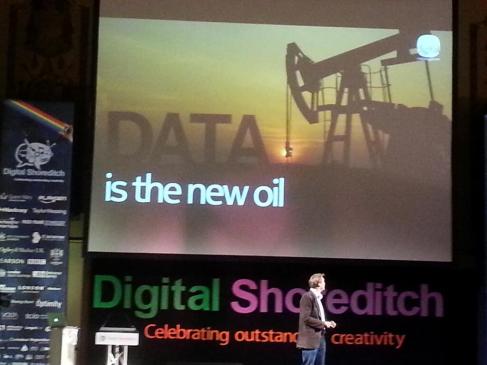Digital Shoreditch is a ten day festival that brings together all those with an interest in digital technologies and the creative industries. The festival is based around Shoreditch, Clerkenwell and Brick Lane. This year over 500 events will take place, ranging from conferences, interactive talks, workshops, hackathons and more.
I attended Future Brands on Tuesday 22 May. This was a day dedicated to the challenges and opportunities in advertising and consumer engagement. Over 40 events were on offer and I had selected eleven of interest to me, but this was optimistic. A run through some the talks follows.
Ben Claxton from NativeEye.com spoke about the possibilities of using mobile phones to gain an insight into what customers, and potential customers, were thinking and experiencing. An example is their site Are you Being Served? which invites people to upload photos of customer service experiences, potentially hugely useful information about brands and companies. The thinking here is that mobile research captures contexts and emotions now. You can ‘borrow’ people’s eyes and ears to learn.
Companies stress the ‘experience’ angle as experiences give more vaue than a mere product. Experiences stay with us whereas product only gives so much enjoyment. Or so the thinking goes. Like much of the day, the catch phrases were flying around and it would have been nice to have had some of this research quantified in some way.
A healthy dose of cynicism was injected by Jon Morter who gave a lively talk about the greatest hits of the condescending corporate brand page. This was very much personal opinion but he cleverly showed the power of social media when he discussed @automatedfail a Twitter account set up as a digital honeytrap (Location: Mugsville. Nothing of any worth whatsoever is tweeted by us) which now has 12,000 followers. Similarly, @Likeourpage had one fan in September 2012 and now has over 40,000 after posting essentially no more than jokey content. The serious point being however that engaging content can and does attract people. He finished with a run down of top five pet hates, such as made up national holidays (National Toilet Day anyone? sponsored by Charmin) to the You Must Comply! type campaign with various threats about cute pets getting it in the neck if you don’t Like, Comment or Share, and the ubiquitious Keep Calm and…You get the picture.
Jed Hallam’s talk on What Happened when Social Media Grew Up was thoughful and relevant. His view that as organisations have SEO strategies, DM strategies, strategies about strategies, content strategies etc they need to think of themselves as social businesses with human insight as part of the organisation’s DNA.
The point was made (again and again and was a theme of the day) that data was the new raw material of business (the new oil as someone else said later in the day). Are we going to see Chief Data Officers? Certainly, social media measurement is meaningless without context.
The other theme was how social media can increase customer acquisition, retain customers, aid innovation and improve product development. Luke Brynley Jones @oursocialtimes made some good points about how the emphasis should be on using social media for customer service rather than getting new customers as on average 80% of future revenue will come from 20% of existing customers. As anyone who has worked in publishing will know, no surprises here. Despite this he claimed global spend on advertising is $500bn, CRM $50bn but a mere $9bn for customer service. Stop feeding the monster!
Ogilvy advertising spoke about the new marketing principles, the key point being that we are moving from selling to satisfying means and the sales talk should be of features and benefits rather than specifics. This seems vary familiar and I’m sure we were saying the same in the 1990s. The point about meeting expectations remains valid however and marketing and design must be better integrated.
Pearson (one of the corporate sponsors, interestingly) talked about a hackathon they ran to develop an app for kids. A hack is a time limited session focused on a specific task with key people working in the same location.
The basement of Shoreditch town hall contained a cool exhibition. The most interesting part for me was an exhibit from Digital Archaelogy.com of significant websites from 1991 set on contemporary hardware. No archive copy or screen shot of the first website created by Sir Tim Berners Lee and the CERN team exists, but a copy from 1992 was on show (image below). In some ways we have come so far.


